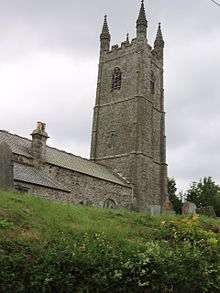Withiel
Withiel (Cornish: Egloswydhyel)[1] is a civil parish and village in mid Cornwall, England, United Kingdom. The parish of Withiel is between the parishes of St Breock, Lanivet, Roche and St Wenn. The name Withiel comes from the Cornish word Gwydhyel, meaning "wooded place".[2] The parish contains the hamlets of Withielgoose, Retire and Tregawne; the parish had a total population of about 300 in 1824.[3]
Withiel
| |
|---|---|
 Withiel | |
 Withiel Location within Cornwall | |
| Population | 331 (United Kingdom Census 2011) |
| OS grid reference | SW995654 |
| Civil parish |
|
| Unitary authority | |
| Ceremonial county | |
| Region | |
| Country | England |
| Sovereign state | United Kingdom |
| Post town | BODMIN |
| Postcode district | PL30 |
| Dialling code | 01208 |
| Police | Devon and Cornwall |
| Fire | Cornwall |
| Ambulance | South Western |
| UK Parliament | |
At Ruthernbridge is an early 15th-century bridge with two pointed arches over the Ruthern. The hamlet here was until 1933 a halt on the Bodmin to Wadebridge railway line. The River Ruthern rises near Victoria in the parish of Roche and flows northwards through the parish of Withiel; it flows into the River Camel one kilometre above Brocton.[4]
Notable people from the parish include Sir Bevil Grenville (1596–July 5, 1643), a Royalist soldier in the English Civil War.
Local government
Withiel Parish Council[5] is the lowest level of government in the parish, its powers are limited, most functions are administered by Cornwall Council or by central government.[6] The parish council is made up of 7 councilors and the clerk. As of 2017 these were: Anna Hoyle, David Cubitt, Guy Nott Bower, Janet Shearer, Patrick Malone, Simon Coy, Eric Harper and the clerk Robin Turner.[7] They meet at the village hall.[8]
Church history

The parish church, dedicated to St Clement, is in the village of Withiel and dates back to the 13th century. The original church was apparently a nave and chancel only but it was rebuilt in the 15th and 16th centuries in granite. At this time a tower and spacious south aisle were added, and later a smaller north aisle, used as a chapel by the Bevilles of Brynn. The dedication to St Clement is not recorded before 1478; St Clement is portrayed on the font which is of this date. The church and manor of Withiel belonged before the Norman Conquest to the monastery of Bodmin; the monastery retained possession until 1538. The benefice was never appropriated and has always been a rectory. Thomas Vivian, Prior of Bodmin, was also rector 1523-1533; his arms are in the east window of the south aisle.[9]
There are two Cornish crosses and a cross base in the parish. One of the crosses is at a road junction about a mile south of the churchtown and the other in the rectory garden. The latter formerly stood in the road outside the rectory but was moved into the garden about 1860; it is in a good state of preservation.[10] The former cross is called Inches Cross; it is thought that most of the cross shaft is buried in the ground.[11]
The Rev. Sir Vyell Donnithorne Vyvyan, 9th Baronet (1826–1917) was Rector of Withiel.[12] His father the Rev. Vyell Francis Vyvyan (1803–77) was also rector of Withiel, for 50 years.[13][14]
References
- Place-names in the Standard Written Form (SWF) : List of place-names agreed by the MAGA Signage Panel. Cornish Language Partnership.
- Mills, A. D. (1981) The Popular Dictionary of English Place-Names, ISBN 0-7525-1851-8
- Hitchins, Fortescue; Drew, Samuel (1824). The History of Cornwall: from the earliest records and traditions, to the present time. W. Penaluna. p. 682. Retrieved 8 October 2011.
- Ordnance Survey (1988) Landranger 200; Newquay, Bodmin & surrounding area, 1:50 000
- "Withiel (Parish Council)". www.cornwallalc.org.uk. Retrieved 5 September 2017.
- Archives, The National. "The Discovery Service". discovery.nationalarchives.gov.uk. Retrieved 5 September 2017.
- Council, Cornwall. "Withiel Parish Council - Cornwall Council". www.cornwall.gov.uk. Retrieved 5 September 2017.
- "Withiel Parish, Cornwall". Withiel Parish, Cornwall. Retrieved 5 September 2017.
- The Cornish Church Guide (1925) Truro: Blackford; pp. 221-22
- Langdon, A. G. (1896) Old Cornish Crosses. Truro: Joseph Pollard; pp. 54, 72 & 423
- Langdon, A. G. (2002) Stone Crosses in Mid Cornwall; 2nd ed. Federation of Old Cornwall Societies; p. 75
- Reverend Sir Vyell Donnithorne Vyvyan, 9th Bt.
- Reverend Vyell Francis Vyvyan
- Mee, Arthur (1937) Cornwall. (The King's England.) London: Hodder & Stoughton; p. 306